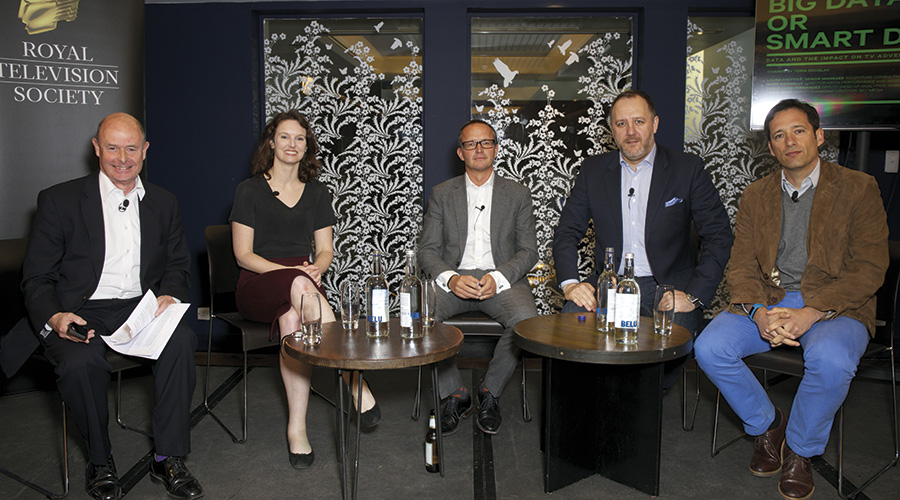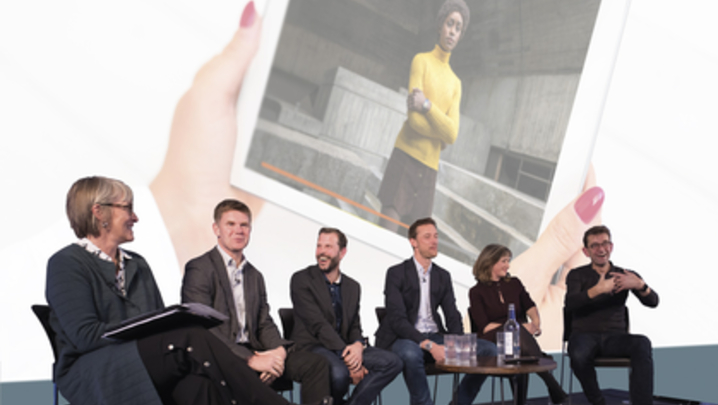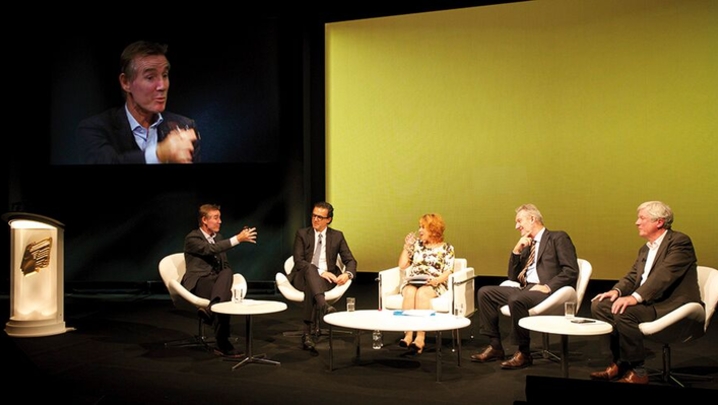Netflix is not alone in using analytics to understand how audiences respond to video content. Matthew Bell reports
Big data, with Netflix at the forefront, is transforming the way that TV is commissioned and watched, but not as radically or quickly as many in the broadcasting industry believe. Its impact, for the moment, remains most keenly felt in advertising.
This was the conclusion of a sold-out RTS early-evening event, “Big data or smart data? Data and the impact on TV advertising, commissioning and content”. Chaired by the former BBC Media Correspondent Torin Douglas, the RTS panel – composed of both broadcasting and advertising experts – explained the appeal of big data.
In a TV context, big data is the digital trail left by viewers as they flick from channel to channel. This information is invaluable for broadcasters and advertisers alike: it reveals the audience’s likes and dislikes and allows broadcasters to target their content more accurately. However, when it comes to informing the creative process, it is still in its infancy.
Unfortunately, the term “big data”, while widely used, is not the only name in town. “We tend to talk about ‘insight’ now, rather than ‘big data’,” said Sky Media Deputy Managing Director Jamie West.
“It was a convenient phrase five or six years ago, but I don’t think it has too much use now,” said Mark Connolly, Media Performance and Investment Director at the advertising agency Havas Media Group. “[The issue is] what you do with [big data], rather than what you call it.”

and Pedro Cosa Fernandez (credit: Paul Hampartsoumian)
And big data is not the only kind of data available to the media industry. “There are lots of different types of data that are useful for decision-making,” said Laura Chittick, Senior Manager at Accenture Digital Video.
Sources include Barb (Broadcasters’ Audience Research Board), which has provided the official viewing figures for UK television audiences, using a panel of 5,100 of households, since 1981.
“Barb is also great, because you know exactly who’s doing what in which household and for what demographic. The combination of both [types of data] is really powerful,” said Chittick. It would seem that Barb ratings are not ready for the scrap heap any time soon.
“Data can help you to understand what audiences are doing,” continued Chittick, providing “insight into consumption and behaviours”. She argued that “average video consumption per user per session” was a key measurement. “You want that to go up because you want to build loyalty and video viewership.”
Chittick added that the “frequency with which people come back to watch content” is also important.
Big data, though, reveals more than viewers’ TV consumption; it also provides information on their willingness to pay for content and stick with ads, rather than changing channels during commercial breaks.
“People will pay for different types of [TV] bundles and put up with different types of advertising. You can learn about what each individual will do,” explained Chittick.
“We use a huge number of data touch points [information from interaction with customers] to help improve our customer experience, said Sky Media’s West. “This is both in terms of how we make decisions on content that we acquire or create and how we promote and schedule that content, through to how we promote product upgrades.”
So-called “addressable TV” enables Sky Media (see box, right) to take personalised advertising a stage further. It allows advertisers to target TV audiences and serve ads to different households that fit certain geographic, demographic and behavioural characteristics.
“Personalisation runs all the way through our business from the call centre to commissioning, to advertising,” added West, who is responsible for the development of emerging advertising opportunities at Sky.
There is a need for gut instinct... Where big data should be used is to highlight opportunities
Sky’s big data is gathered from more than 3 million Sky households. Customers give (or refuse) their consent for Sky to use this data when they first subscribe. At any point during their contract customers can withdraw their consent.
“The data gives us a huge insight into who’s watching, the type of audience, what is working and what is not working,” said West.
Pedro Cosa Fernández, Channel 4’s Deputy Head of Analytics, would love to get his hands on this type of data. “It’s something that we would like to have, but we do not have the commercial relationship with our viewers [that Sky has],” he explained.
As a linear TV broadcaster, Channel 4 does not have “the one-to-one relationship with viewers that pay-channels have [with their subscribers]. We’re missing the data that goes with [subscriptions],” continued Cosa, who is responsible for digital audience analysis at Channel 4.
The broadcaster’s own big data is derived from the usage of its on-demand player, All 4, but does not include how audiences watch Channel 4’s linear channels.
“That TV data can be got from set-top boxes that Sky, Virgin, Freesat or YouView have, but we don’t have,” added Cosa.
Douglas asked Cosa whether he thought Channel 4 had a right to this data. “Yes,” he replied. “And we’ve had discussions about it.”
“The ownership and control of data is often overlooked,” argued Havas Media Group’s Connolly. He explained that “personally identifiable information” from viewers had to be regulated and made anonymous. “It’s too easy to get hold of data and use it in the wrong ways.”
Big data is widely used to provide personalised advertising but, asked Douglas: “How close are we to a proper personalised offer [of content] to viewers?”
“We have a big programme around recommendations,” said Cosa. “As a public service broadcaster, it’s really important to not just maximise our revenue and number of views but to also meet our public service remit, which is about enabling [viewers] to discover new shows.”
Going further and using big data to influence TV content and commissioning, admitted Cosa, threw up many challenges, not least because of the potential conflict between the science of big data and the art of programme-making.
For the moment, Channel 4 is experimenting with its video-on-demand data. “All 4 now has original commissions that are especially made for online rather than linear channels,” said Cosa. “That is where the data is used, and we’re trying to use this as a platform where we can explore and apply data in a more free way.”
Chittick agreed with Cosa that commissioning was “a harder area” in which to apply data. She said that, typically, programme-makers found it difficult to assimilate large sets of data and work with analytics teams.
The way forward, she suggested, was to “bring these two together in a multi-disciplinary team”.
Using data in TV is not a new phenomenon, said Douglas, pointing out that TV shows had long been commissioned, recommissioned or chopped on the basis of audience research. What had changed, he suggested, was that now “there’s an awful lot more data and [broadcasters] can do more with it”.
It's too easy to get hold of data and use it in the wrong ways
US streaming giant Netflix, Douglas pointed out, had taken advantage of the vast amount of big data at its fingertips. It had based its content acquisition and development on a detailed analysis of the viewing habits of its worldwide subscriber base. “Is this a game changer?” he asked.
“Yes,” replied Connolly. “Netflix develops content that is based on big data. If it knows that this data has been analysed really well, it commissions content that is based around this.”
He added: “It is challenging and changing the dynamics of the TV market. There is no doubt that TV viewing is having to change because of Netflix and Amazon Prime.”
Sky Media’s West denied that over-the-top (OTT) TV was a threat to Sky. “In the UK, what we’re seeing more of are OTT services being bought in addition to Sky or other pay-TV services,” he argued. “Speaking to my peers at Virgin, they are seeing similar things – Netflix is additive, rather than cannibalising the existing pay-TV market.”
West, however, conceded that the OTT companies were having an impact on content commissioning. Netflix’s series about the British royal family, The Crown, which will air in the UK from November, is reputed to have cost £100m to make.
“The amount of money that the global content business can spend on a programme or event is so vastly different to a business with even the budgets of Sky,” he said. “We haven’t got the power to compete with Netflix on a particular show.”
Doubts about Netflix’s claim that it commissions hit series such as House of Cards on the basis of data analysis persist, largely because the company refuses to release ratings information.
“It doesn’t share the data to [prove] that, but, to be fair, it keeps coming up with hit series after hit series,” said Connolly.
“How do we know they are hit series?” asked Douglas. “Because Netflix tells us so,” replied Connolly.
Douglas refused to take that at face value: “A lot of people say it’s hype. It is more than hype, but Netflix doesn’t share its viewing figures. It doesn’t make a profit. How do we know what’s going on at Netflix?”
The extent to which the streaming service uses big data to create content is disputed. Channel 4’s Cosa reckoned Netflix uses data “more for validation than [content] creation. It knows its customer base and it can validate its investment and look at the potential of acquiring content.”
Programme-makers, he added, understand that using big data to inform content “is going to be big in the future”, but currently it is used more in scheduling than for taking creative decisions.
Sky changes face of TV ads
Big data has been mined most deeply in the advertising field. At this RTS early-evening event, Sky Media’s Jamie West discussed how the pay-TV company has used analytics to offer more to advertisers.
In January 2014, Sky launched AdSmart. This allows advertisers to show different commercials to homes watching the same television programme. The ‘addressable TV’ product is based on 940 attributes or data points. These can be combined to create unique buying audiences for advertisers.
Using publicly available information to identify groups or demographics, AdSmart enables advertisers ‘to target households to drive more effective advertising outcomes. For us, it was about making TV advertising more relevant to more brands,’ said West.
‘When we serve a relevant ad to a household, channel switching reduces by 33% over the ad break – that, for me, means that, if you serve relevant ads, you get a more engaged audience,’ he added.
In autumn 2015, Sky AdVance came on to the market. This allows advertisers to deliver multi-platform campaigns across different screens, so that audiences see the right ad at the right time, in the right sequence and on the right screen. At the heart of Sky AdVance is big data, which is gathered from more than 3 million Sky households, providing second-by-second viewing data.
West also revealed that Sky is building data visualisation tools ‘to delineate the effects of an advertising campaign. Agencies and advertisers will be able to press a button and see how their campaigns are performing.’
Havas Media Group’s Mark Connolly argued that ‘big data is changing media consumption – clients are spending less money but are prepared to pay higher prices for the media they buy because they can individually control how much value every single impression or TV ad spot [offers].’
Question & answer
Q.Barb is the ratings currency for broadcasters and advertisers, but what Sky is offering is a lot more useful. When are we going to be able to use your information?
A.Jamie West, Sky Media Deputy Managing Director: Barb is the gold standard and hugely accurate at measuring audiences at scale. I passionately believe that Barb, as a panel, will be there for the long term.…
In terms of how we share data with partners, we are open to conversations. We do make elements of our panel open to third parties, but it is a conversation about how you [get] that data.
What’s the value exchange? We’ve invested millions of pounds in building a panel and millions of pounds maintaining that panel. It’s not something we’re going to give away for free.…
Be absolutely clear, what we are not doing is giving any personal, identifiable data. We’re giving aggregated, anonymised data.
Q.Do you think that Barb is here to stay?
A.Mark Connolly, Media Performance and Investment Director, Havas Media Group: Yes, because of the independent nature of it.
Q.Is big data just for big corporates?
A.Mark Connolly: I don’t buy into that.… [The key is] to use data intelligently.
A.Laura Chittick, Senior Manager, Accenture Digital Video: Operationally, it could be easier [to be small]. A lot of the corporates that we work with face challenges in terms of the silos they themselves create and the way they work.
Q.How expensive is it to have access to big data? Is that beyond small companies?
A.Laura Chittick: I don’t think so these days. You’ve got a bunch of different data sources. Depending on what you want to do with it, you don’t have to industrialise it into big-data platforms.… It doesn’t have to be a huge technology investment.
A.Mark Connolly: Big data can be whatever you want it to be.… It doesn’t have to be expensive: [the cost] depends on what you actually want to do with that data.
Q.Is there a danger that data will kill creativity? Is there still a place in TV for gut instinct?
A.Mark Connolly: Yes, 100% there’s a need for gut instinct.… Where big data should be utilised is to highlight opportunities but…to have that human interaction… is absolutely necessary, both on the media-execution side and also the creative side.
A.Pedro Cosa Fernández, Deputy Head of Analytics, Channel 4: We’ve been trying to use data to make decisions more on a research and development basis. [The quetion] “Would you watch [the programme] again?” is something that a machine can’t really [answer].
A.Laura Chittick: The curation and editorial [decisions] that people love about broadcasting brands will remain a differentiator. I watch BBC Four because I love the programmes that people create on it.…
That brand attachment is going to stay and that is what broadcasters are really good at.
‘Big data or smart data? Data and the impact on TV advertising, commissioning and content’ was held at The Hospital Club in central London on 19 April. It was produced by Vicky Fairclough.






